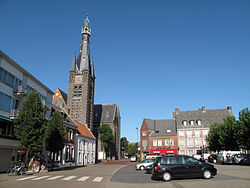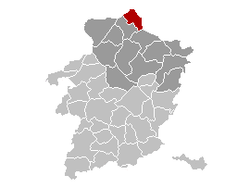Hamont-Achel
| Hamont-Achel | |||
|---|---|---|---|
| Municipality | |||
 |
|||
|
|||
| Location in Belgium | |||
| Coordinates: 51°15′N 05°33′E / 51.250°N 5.550°ECoordinates: 51°15′N 05°33′E / 51.250°N 5.550°E | |||
| Country | Belgium | ||
| Community | Flemish Community | ||
| Region | Flemish Region | ||
| Province | Limburg | ||
| Arrondissement | Maaseik | ||
| Government | |||
| • Mayor | Theo Schuurmans (CD&V) | ||
| • Governing party/ies | CD&V | ||
| Area | |||
| • Total | 43.66 km2 (16.86 sq mi) | ||
| Population (1 January 2016) | |||
| • Total | 14,356 | ||
| • Density | 330/km2 (850/sq mi) | ||
| Postal codes | 3930 | ||
| Area codes | 011 | ||
| Website | www.hamont-achel.be | ||
Hamont-Achel (Dutch pronunciation: [ˈɦaːmɔnt ˈɑxəl]; Limburgish: Haëmet-Achel) is a municipality located in the Belgian province of Limburg. It was founded in 1977 by a fusion of the city Hamont and the village Achel. On January 1, 2006, Hamont-Achel had a total population of 13,770. The total area is 43.66 km² which gives a population density of 315 inhabitants per km². The municipality houses the Trappist Abbey of Achel, part of which is Brouwerij de Achelse Kluis, one of the 11 Trappist breweries.
The professional cyclist Jelle Vanendert lives in Hamont-Achel.
On 18 November 1918, the municipality was the site of one of the worst train explosions in history, when two German munitions trains caught fire and exploded. Not only were the trains destroyed, but three German ambulance trains were also wiped out, along with most of the town. More than 1,000 individuals were killed.
...
Wikipedia




